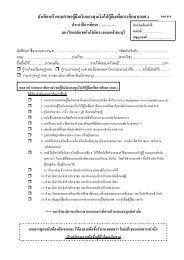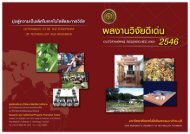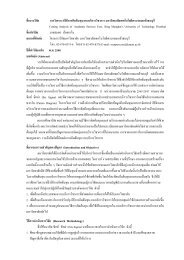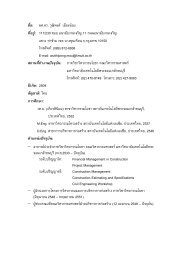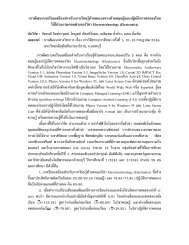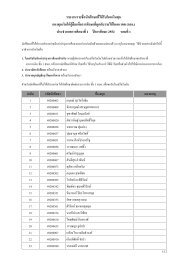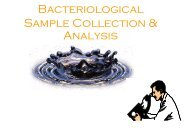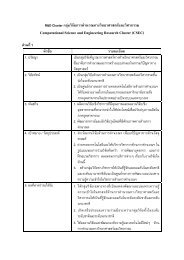Create successful ePaper yourself
Turn your PDF publications into a flip-book with our unique Google optimized e-Paper software.
22<br />
maximum of which was achieved at 20.00 GPa.<br />
The presence of F-type defects in AlN films was<br />
investigated by X-band (~9.44 GHz) ESR<br />
spectrometer at 295 K. The ESR experiments<br />
were carried out by applying magnetic field<br />
perpendicular to AlN film, which showed the<br />
ESR six-peak multiplet signal at ~290 mT<br />
arising from superhyperfine interactions<br />
between nuclear spin I = 5/2 of 27 Al and electron<br />
spins trapped in nitrogen vacancies. The ESR<br />
signals are simulated and the ESR parameters<br />
are calculated. The vacancies are clearly<br />
randomly distributed as the ESR signals are<br />
independent of rotation angle (φ) about the<br />
normal of the film. All these results were<br />
analyzed and presented as a function of the<br />
deposition parameters and composition, and<br />
crystalline phases existed in the films.<br />
IJ-061 EFFECTS OF HEAT TREATMENT ON<br />
BLUE SAPPHIRES AS MONITORED BY ESR<br />
SPECTROSCOPY<br />
Nitinai Udomkan, Pichet Limsuwan,<br />
Pongtip Winotai, Siwaporn Meejoo<br />
International Journal of Modern Physics B,<br />
Vol. 19, No. 20, 2005, pp. 3273-3284<br />
We report effects of heat treatments on<br />
physical properties and finding optimal heating<br />
condition to add value to Thai blue sapphires.<br />
The color of sapphire arises from the presence of<br />
trace 3d-transition ions in its crystal lattice. For<br />
blue sapphire, the color is due to a charge<br />
transfer mechanism between Fe 2+ and Ti 4+ ions.<br />
However, iron may adopt both Fe 3+ and Fe 2+ due<br />
to oxygen vacancies. Fe 3+ and Fe 2+ yield<br />
sapphire yellow and green colors, respectively.<br />
Therefore, we have to convert as many as<br />
possible of Fe 3+ to Fe 2+ by heating the blue<br />
sapphire in N2 atmosphere for 12 h.<br />
Experimental results reveal that the ratio of<br />
lattice parameter c/a increases with the heating<br />
temperature and reaches maximum at 1700°C,<br />
which can be caused by displacement of Fe 3+<br />
ions or more Fe 3+ ions being converted to Fe 2+ .<br />
ESR signals show that the number of Fe 3+ ions<br />
decreases roughly linearly with the heating<br />
temperature. The intense sky blue color was<br />
achieved after the 1500°C heat treatment, having<br />
the Fe 3+ / Fe 3+ RT ratio ~0.78. The optimal heat<br />
treatment should therefore be at 1500°C in<br />
flowing N 2 atmosphere for Thai blue sapphires<br />
which yield intense sky blue color and good<br />
crystal clarity. The blue sapphires exhibited<br />
KMUTT Annual Research Abstracts 2005<br />
good clarity but light sky blue due to the<br />
increase in lightness after the treatment at<br />
1700°C. A monoclinic distortion of the<br />
corundum structure has been found to start at the<br />
1600°C treatment by ESR spectrometer. This is<br />
also clearly evident from low angle shifts of<br />
XRD peaks after heating at 1700°C. We can<br />
therefore conclude that the color change of Thai<br />
blue sapphires arises from the conversion of Fe 3+<br />
to Fe 2+ and thus the change in crystal field. The<br />
monoclinic distortion of the crystal structure<br />
may also play an important role in coloring the<br />
sapphires after the heat treatment at 1600-<br />
1700°C.<br />
IJ-062 ELECTRON SPIN RESONANCE<br />
STUDIES OF MN 2+ IN FRESHWATER SNAIL<br />
SHELLS : POMACEA CANALICULATA<br />
LAMARCK AND FOSSILIZED SNAIL SHELL<br />
Nitinai Udomkan, Siwaporn Meejoo,<br />
Pichet Limsuwan, Pongtip Winotai,<br />
Yaowalak Chaimanee<br />
Chinese Physics Letters, Vol. 22, No. 7, July<br />
2005, pp. 1780-1783<br />
We study paramagnetic Mn 2+ ions<br />
present in the nowadays shells of univalve<br />
freshwater snails of Pomacea canaliculata<br />
lamarck (PCL) and the fossilized freshwater<br />
snail (FFS), Viviparus. All these shells are<br />
abundant in Thailand. The PCL shells were<br />
ground into fine powder. A set of seven samples<br />
were then separately annealed for 2 h in air<br />
atmosphere at different annealing temperatures<br />
while the FFS powder was characterized asreceived.<br />
The PCL shells mainly consist of<br />
aragonite and a fraction of calcite. The heat<br />
treatments of the PCL powder samples at<br />
temperature higher than 450 o C resulted in an<br />
irreversible phase transformation from aragonite<br />
to calcite. However, it is found that the FFS<br />
shell is mainly made of calcite, with a minor<br />
fraction of aragonite. The crystal structure of the<br />
high-temperature-annealed PCL samples are<br />
quite similar to that of FFS, which indicates that<br />
the metamorphosis (aragonite → calcite) in the<br />
FFS shell had occurred but was not yet<br />
completed, although it had remained under the<br />
pressure and temperature of the Earth's crusts<br />
over millions of years. Our detailed ESR<br />
spectral analyses of PCL and FFS show that<br />
Mn 2+ ions enter the Ca 2+ sites during a<br />
biomineralization process. Simulated ESR<br />
parameters of PCL-500 of Mn 2+ at a uniaxial site<br />
International Journal



